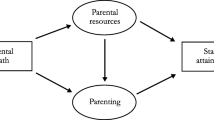Abstract
In spite of relevant differences between countries, a common international pattern emerges: daughters leave parental homes earlier than sons. Drawing upon the European Community Household Panel, we explore the impacts of various factors that affect daughters’ and sons’ home-leaving decisions. Our results show important differences across genders as well as across countries. The decisions of daughters appear to be more responsive than sons’ to family structure as well as to institutional factors such as the labor and the mortgage market.


Similar content being viewed by others
Notes
According to Reher (1998), these differences have historical roots. The Northern European pattern of “weak family ties” and early transition to adulthood is linked to the medieval habit of leaving the parental home early for agricultural work or to become a servant. On the contrary, in Southern Europe, the “strong family ties” pattern was characterized by extensive periods of co-residence parents and adult children, in some areas extending to the whole life.
The ECHP breaks down total income in three mutually exclusive categories, referred to as public income, work income, and private (non-work) income. The first category comprises in particular social insurance receipts, family allowances, and sickness or invalidity benefits.Work income refers to wage and salary earnings or self-employment income. Non-work private income includes private transfers from other household members.
In Northern countries where elderly coresidence with offspring is less prevalent, the well-being of the elderly is based on residential autonomy or on private or public nursing homes.
References
Aassve, A., Billari, F., Mazzuco, S., & Ongaro, F. (2001). Leaving home ain’t easy. A comparative longitudinal analysis of ECHP data, MPIDR WP. 2001-038.
Aassve, A., Iacovou, M., & Mencarini, L. (2006). Youth poverty and transition to adulthood in Europe. Demographic Research, 15, 21–40.
Becker, S., Bentolila, S., Fernandes, A., & Ichino, A. (2005). Youth emancipation and perceived job insecurity of parents and children. IZA D.P. 1836.
Billari, F., & Kohler, H. (2004). Patterns of low and lowest-low fertility in Europe. Population Studies, 58(2):161–176.
Billari, F., Philipov, D., & Baizán Munoz, P. (2001). Leaving home in Europe: The experience of cohorts born around 1960. MPIDR Working Papers WP-2001-014.
Cammelli, A. (2005). La transizione dall’università al lavoro in Europa, Il Mulino.
Card, D., & Lemieux, T. (2000). Adapting to circumstance: The evolution of work, school and living arrangements among North American Youth. In D. Blanchflower, R. Freeman (Eds.), Youth employment and joblessness in advanced countries. Chicago: University of Chicago Press.
Chamberlain, G. (1980). Analysis of covariance with qualitative data. Review of Economic Studies, 47, 225–238.
Chiuri, M. C., & Del Boca D. (2008). Household membership decisions of adult children. IZA DP 3546.
Chiuri, M. C., & Jappelli, T.(2003). Financial market imperfections and home ownership: a comparative study. European Economic Review 47, 857–875.
Dalla Zuanna, G., & Micheli, G. (Eds.). (2004). Strong family and low fertility: A paradox?. Dordrecht/Boston/London: Kluwer.
Davanzo, J. F., & Goldschieder, K. (1990). Coming home again:returns to the parental home of young adults. Populations Studies, 44(2), 241–255.
Ermisch, J. (1999). Prices, parents and young people’s household formation. Journal of Urban Economics, 42, 1–17.
Esping-Andersen, G. (1999). Social foundations of postindustrial economies. Oxford: Oxford University Press.
Giannelli, G., & Monfardini, G. (2003). Joint decisions on household membership and human capital accumulation of youths. The role of expected earnings and local markets. Journal of Population Economics, 16(2), 265–285.
Grossbard, S., & Amuedo-Dorantes, A. (2007). Cohort-level sex ratio effects on women’s labor force participation. Review of Economics of the Household, 5(3), 249–278.
Kaplan, G. (2009). Moving back home:insurance against labor market risk mimeo NYU.
Le Blanc, D., & Wolff, C. (2006). Leaving home in Europe: The role of parents’ and children’s incomes. Review of Economics of the Household, (4), 53–73.
Maclennan, D., Muellbauer, J., & Stephens, M. (1998). Asymmetries in housing and financial market institutions and EMU. Oxford Review of Economic Policy, 14(3), 54–80.
Martins, N., & Villanueva, E. (2006). Does limited access to mortgage debt explain why young adults live with their parents? Working Papers 0628, Banco de Espana.
McElroy, M. (1985). The joint determination of household membership and market work: The case of young men. Journal of Labor Economics, 3(3), 293–316.
Nicoletti, C., & Peracchi, F. (2005). Survey response and survey characteristics: Microlevel evidence from the European Community Household Panel. Journal of the Royal Statistical Society Series A, Royal Statistical Society, 168(4), 763–781.
Parisi, L. (2008). Leaving home and the chances of being poor: The case of young people in Southern European countries. Labour, 22(Special Issue), 89–114.
Reher, D. S. (1998). Family ties in Western Europe persistent contrasts. Population and Development Review, 24(2), 203–234.
Rosenzweig, M., & Wolpin, K. (1993). Intergenerational support and the life-cycle incomes of young men and their parents: Human capital investments, coresidence, and intergenerational financial transfers. Journal of Labor Economics, 11(1), 84–112.
Rosina, A. (2004). Family formation and fertility in Italy. In G. Dalla Zuanna, G. A. Micheli (Eds.), Strong family and low fertility: A paradox? London: Kluwer.
Acknowledgments
We thank Anna Laura Mancini and Salvatore Nunnari for excellent research assistance and three anonymous referees fo useful suggestions on a previous draft. The paper was presented at Centro Dondena at Bocconi University and the Conference “The Household and the Labor Market” AIEL-CHILD-Labor at Collegio Carlo Alberto.
Author information
Authors and Affiliations
Corresponding author
Appendix
Appendix
See Table 6
.
Rights and permissions
About this article
Cite this article
Chiuri, M.C., Del Boca, D. Home-leaving decisions of daughters and sons. Rev Econ Household 8, 393–408 (2010). https://doi.org/10.1007/s11150-010-9093-2
Received:
Accepted:
Published:
Issue Date:
DOI: https://doi.org/10.1007/s11150-010-9093-2




